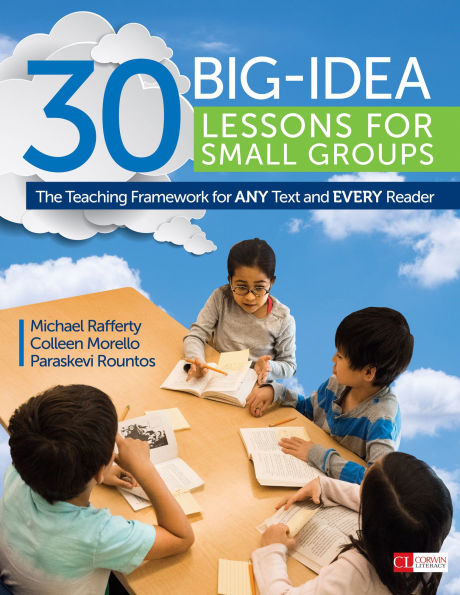Intermediate grade readers are not an M, an N, or an O—they’re idea-wranglers, ready to comprehend when we honor who they are as thinkers first
In 30 Big Idea Lessons for Small Groups, educators Rafferty, Morello, and Rountos provide an amazing framework that gets students interacting with texts. You prompt and guide, but they think! Big-Idea groups are the piece that’s been missing from small group instruction: engagement from the get-go.
Follow this unique 4-part process to develop students’ literal, inferential, evaluative, and analytical skills:
- Engage: Before Reading Using a tactile tool like a topic card or a pyramid, readers literally move ideas around on their small group table as they debate a question related to the text and to big ideas about courage, persistence, love, and honesty, and more.
- Discuss: During Reading Students read and mark up a short text, exploring questions that get at the author’s take on the big idea, noticing key vocabulary, text structure, moments of inference, and more.
- Deep-See Think: After Reading Students re-read, synthesize, and revise their interpretations together and tweak the tactile tool, based on questions that probe the big idea in new and deeper ways.
- Connect: After Reading Students summarize, and begin to transfer their understandings to other texts in independent reading and the world beyond, primed for this all-important transfer because they’ve been engaged in topics that clearly relate to their lives.
Tap into 30 lessons organized by text complexity, reproducible forms, assessments, and a bank of engagement tools so you can switch it up. Use these lessons across the year as a warm up to a whole-class novel, to augment your core reading program, to challenge your capable readers and bring your striving readers in to rich yet accessible reading experiences.
Intermediate grade readers are not an M, an N, or an O—they’re idea-wranglers, ready to comprehend when we honor who they are as thinkers first
In 30 Big Idea Lessons for Small Groups, educators Rafferty, Morello, and Rountos provide an amazing framework that gets students interacting with texts. You prompt and guide, but they think! Big-Idea groups are the piece that’s been missing from small group instruction: engagement from the get-go.
Follow this unique 4-part process to develop students’ literal, inferential, evaluative, and analytical skills:
- Engage: Before Reading Using a tactile tool like a topic card or a pyramid, readers literally move ideas around on their small group table as they debate a question related to the text and to big ideas about courage, persistence, love, and honesty, and more.
- Discuss: During Reading Students read and mark up a short text, exploring questions that get at the author’s take on the big idea, noticing key vocabulary, text structure, moments of inference, and more.
- Deep-See Think: After Reading Students re-read, synthesize, and revise their interpretations together and tweak the tactile tool, based on questions that probe the big idea in new and deeper ways.
- Connect: After Reading Students summarize, and begin to transfer their understandings to other texts in independent reading and the world beyond, primed for this all-important transfer because they’ve been engaged in topics that clearly relate to their lives.
Tap into 30 lessons organized by text complexity, reproducible forms, assessments, and a bank of engagement tools so you can switch it up. Use these lessons across the year as a warm up to a whole-class novel, to augment your core reading program, to challenge your capable readers and bring your striving readers in to rich yet accessible reading experiences.

30 Big-Idea Lessons for Small Groups: The Teaching Framework for ANY Text and EVERY Reader
248
30 Big-Idea Lessons for Small Groups: The Teaching Framework for ANY Text and EVERY Reader
248
Product Details
| ISBN-13: | 9781506348629 |
|---|---|
| Publisher: | SAGE Publications |
| Publication date: | 04/13/2016 |
| Series: | Corwin Literacy |
| Sold by: | Barnes & Noble |
| Format: | eBook |
| Pages: | 248 |
| File size: | 56 MB |
| Note: | This product may take a few minutes to download. |
